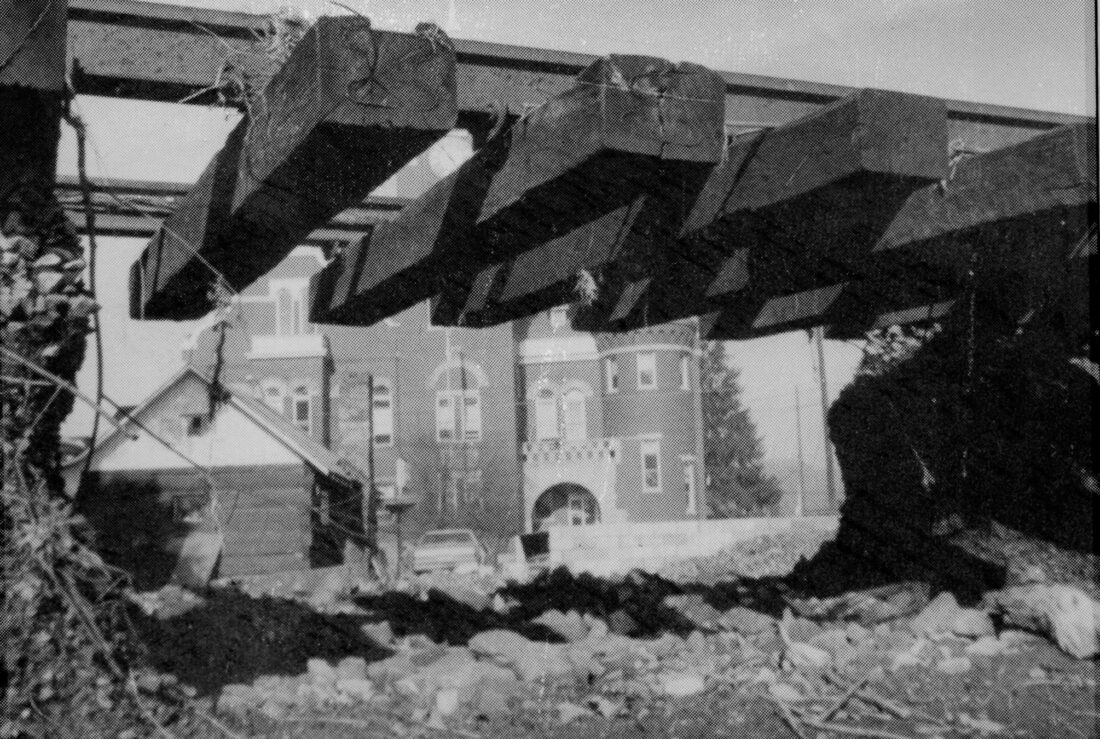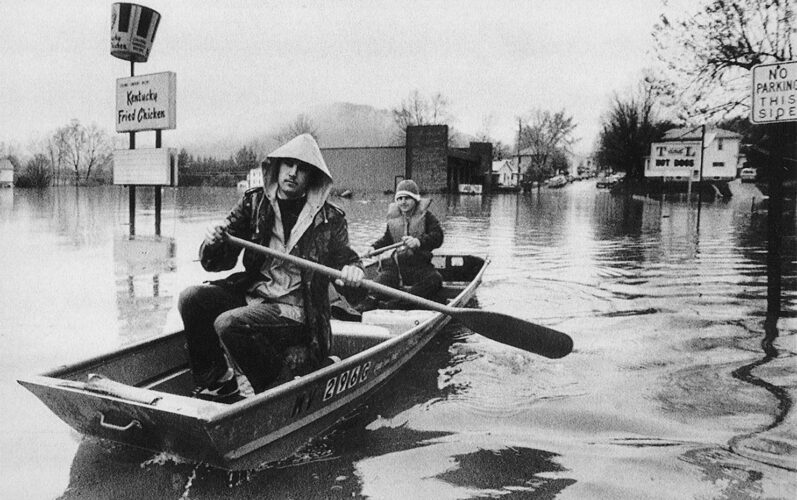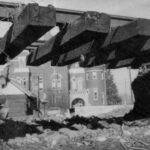40 Years Ago Today
Devastation of ‘85 flood recalled

File photo The Tucker County Courthouse is seen from underneath decimated railroad tracks in Parsons after the destructive flooding of Nov. 4-5, 1985.
ELKINS — On this day 40 years ago, West Virginia faced one of the worst natural disasters in the state’s history, the Flood of 1985, also known as the 1985 Election Day floods or the Killer Floods of 1985.
In the aftermath, 29 counties were declared disaster areas by then-president Ronald Reagan, and at least 47 West Virginians lost their lives.
The damages to the land, property and infrastructure were also extensive, with it being reported from Charleston following the flood that flood that approximately 1.15 million turkeys, 1.6 million chickens and 5,000 cattle were killed during the incident.
According to the West Virginia Encyclopedia Online, rainfall rates for Nov. 4, 1985 saw three to six inches in 12 hours. The remnants of a late-season tropical storm named Juan, the rain that accumulated from the early morning hours of Nov. 4 to nearly 24 hours later on Nov. 5 caused many of the state’s rivers to rise rapidly and reach new record crest heights.
“In response to the rain, many head-water rivers rose rapidly with the onset of darkness that Monday evening,” the West Virginia Encyclopedia Online states. “Severe flooding took place overnight. After midnight, the rain became lighter, but by then, fatal flooding was under way.”
One of the hardest-hit counties in the state was Tucker County. On Nov. 20, 1985, The Parsons Advocate reported that the rising floodwaters of the Blackwater, Black Fork, Shavers Fork and Cheat rivers caused more than $40 million in real estate damages in the county.
On Nov. 27, 1985, it was reported that then-West Virginia Governor Arch A. Moore Jr. declared Parsons to be the “hardest-hit community in West Virginia.”
“Reporting from Governor Moore’s office, Charlotte Roberts said last week that 352 households were displaced in Tucker County,” The Parsons Advocate reported on Nov. 27, 1985. “275 homes were destroyed; and 266 were damaged with only 28 of those considered to have had minor damages. There have been 92 homes condemned, (Roberts) said.”
As one anonymous emergency service member recalled in The Parsons Advocate, evacuations during the flood were strenuous and dangerous. Many people did not wish to leave their homes, even as the water level rose to waist height.
“The water is up to our knees in many places, but we continue. Several elderly women are carried to the units to be evacuated,” the EMS worker recounted in the article. “Word is received that one of our fire trucks attempting to perform a rescue is lost in the Holly Meadows area. I hope the crew is OK We continue to evacuate. How many have we moved? I don’t know. A lot. Many still don’t want to leave and we plead with them. The water is up to our waist in many places and extremely swift. We are told to get the units out before we lose them. We are soaking wet.”
In Barbour County, things were no better. An Inter-Mountain article from 1985 reported that Belington suffered $8 billion in damages from the flood waters, with all businesses and more than 200 homes damaged.
Former Philippi Chief of Philippi Police Gerald “Bucky” Gaynor, who was on the force in 1985, recently recalled that time 40 years ago, and having to evacuate people via boats, one of which was donated by a local resident. At one point a boat had to be pushed into a building to help people get down from the higher floors. The mayor and two city employees also had to be evacuated from City Hall at the time, Gaynor said.
“I remember (the water) was up to my badge,” Gaynor told The Inter-Mountain last week. “It was up to my badge on Main Street. There were cars that were washed from the south side of town over to the north side on the street.”
When asked what emotions were like at the time, Gaynor remembered just how shocked everyone was by the sudden rise in the water levels and how little time they had to move vehicles or to get to other locations.
However, Gaynor added that the Philippi community was not deterred by the misfortune, despite recovery taking more than a year for some in the area.
“People started moving around, helping each other out,” Gaynor said. “Local people came with trucks… It was a community thing and they really came together. It was amazing.”
Conditions and the safety of the community at large was also a major issue in Randolph County.
In one harrowing account, Crystal Springs resident Bill Painter recalled during the week of the flood how he and his wife Margaret had been returning from a marathon in Washington D.C. when they became stuck in the flood in Petersburg. While both tried to wade through the rushing waters, they were swept up and ended up floating on a piece of a roof. Eventually, they were separated by the current.
“We floated down stream about three miles on a section of the roof, then it overturned and I lost hold of her,” Painter told former Inter-Mountain editor Eldora M. Nuzum. “The current was so swift that it kept me under for about 20 seconds.”
Though Margaret was only reported missing at the time Painter was interviewed by Nuzum, online records show she was killed in the flood. She was 29 years old. When Painter returned to Crystal Springs he found his and Margaret’s home had been flooded as well, with “18 inches of water inside the house and three feet of water in the garage.”
As many did at the time, the people of Randolph County rallied around their neighbors and community.
In Harman, Rachel Vance told The Inter-Mountain that, after fleeing the flooding of the Dry Fork River with her husband and 6-month-old son, friends and neighbors were beginning to come by and bring items they had found and knew belonged to the couple. This included wedding pictures found three miles away.
Friends and neighbors also began bringing news items to help the young couple and their son, Vance said.
“Everybody brought food and clothes and the best thing was how they helped the baby,” Vance said in a 1985 article. “People brought him a baby bed and a walker and he has more clothing and toys now than ever before.”
In Pocahontas County, communities and businesses were shaken by the flooding.
According to an article from that time, Marlington Fire Chief Fred Burns said the town had lost 100% of its businesses, with 95% of homes sustaining damage. Burns added there were some homes they couldn’t even find, stating that “if this isn’t a disaster area, I don’t know what is.”
However, business owners were not deterred by the devastation of the flood. As many told The Inter-Mountain soon after the flood, they planned to reopen their businesses as soon as they could.
R.L. Meadows, who owned a restaurant in downtown Marlington at the time, told Isner that, despite the approximately $200,000 worth of damage between his restaurant and his son’s attached floral and gift shop, they wanted to have the restaurant reopened by the winter of 1985 or the spring of 1986.
“We were in the restaurant Monday night of the flood and we watched the water rise up to the front door window,” Meadows told Isner. “I believe though that we waited too long to leave because the water was up to our chest when we went outside.”
In Upshur County, initial reports stated that two residents had lost their lives in the flood. Elizabeth Jean Lane, 57, of Adrian and Joseph Gould Jr., 59, of Buckhannon. No one from Buckhannon was reported missing.
The flooded area of West Virginia was declared a federal disaster area on Nov. 7, 1985. Federal assistance to the area totaled $285 million overall.
A telethon was held on West Virginia public television and radio on Dec.7, 1985, hosted by John Denver, famous for recording “Take Me Home, Country Roads,” the unofficial West Virginia state song.
The telethon ultimately raised $1.7 million for storm victims in the state.

Photo courtesy of the West Virginia Humanities Council
Residents paddle through the streets of downtown Philippi during the historic flooding of November 1985.




